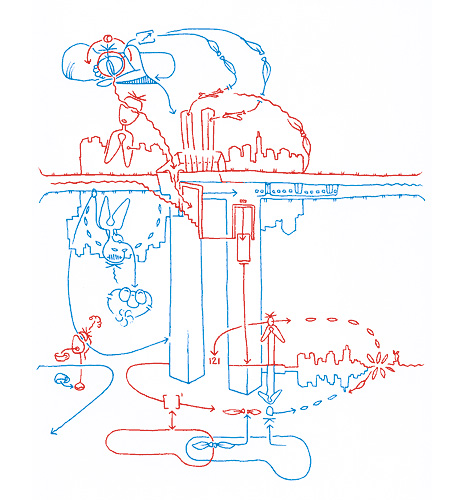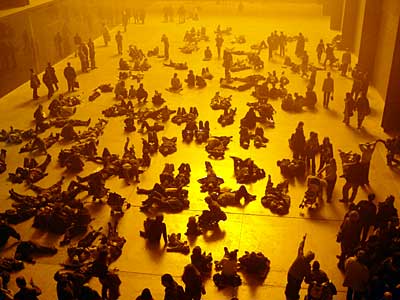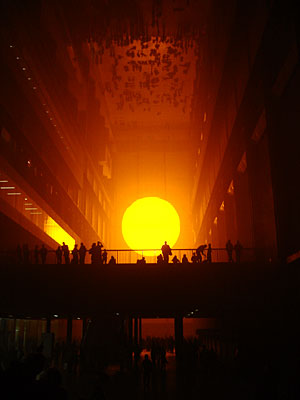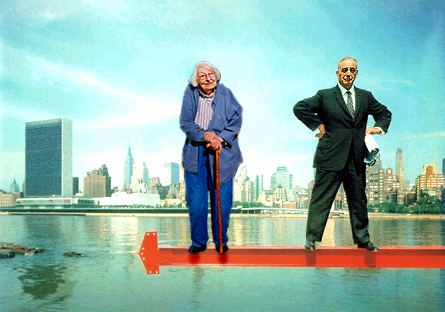As with many public space elements, Paris trumps New York.
In Paris
In New York (image from NewMexican.com)
11.28.2006
Chic public toilets
Posted by Shin-pei at 12:17 PM 5 comments
Identity overhaul, and a public space story
Postings have been light of late, mostly because I'm considering a small overhaul of the site, one that will hopefully steer BttN closer to my observations of public spaces. For those who are still reading, thanks for tuning in.
Yesterday, the weather was warm enough to have lunch outside. It was even warm enough to sit on a granite bench in front of a water fountain of a large office building on Sixth Avenue. There were two chicken and rice guys on both street corners, and a fruit vendor - all vendors were doing well, with a small line even after 1:30PM.
While we ate with a view overlooking the street, a homeless person decided to go coin-diving in the fountain. The weather was cooperating, I suppose. There weren't too many coins to be had, but perhaps it was also fun to be in water, especially when the sun is out.
This could have been unsettling, and maybe in a less busy downtown it would have induced some general fear if I was the only person near the fountain, but with all sorts of people bustling about, eating lunch, and the vendors "guarding" each street corner, the homeless guy attracted nary a side glance. And maybe because he didn't attract any attention at all, he waded through the fountain and was off without an incident, and a couple dollars richer, in less than a minute.
When he left, a group of young Japanese media types just finished buying their lunch from a chicken/rice vendor. Lunch in hand, they walked the perimeter of the fountain, assessing their sit-down options. By this time, most people had finished lunch and they had several empty benches to choose from. And where did they choose to cluster? Right next to me, the only other person in the area still eating lunch.
Posted by Shin-pei at 11:39 AM 0 comments
11.23.2006
Making the best of scaffolding
I like the thoughtfulness that went into this too.
Posted by Shin-pei at 8:24 PM 0 comments
11.16.2006
Two is too close for comfort
It's now been several days since I meant to post this!
A fun piece in the NYT about personal space in public spaces.
Posted by Shin-pei at 10:43 AM 0 comments
11.15.2006
New York Regional Trends 2006

The Allen Room at Jazz at Lincoln Center. Now imagine the chairs filled with dark suits; now you have a good picture of the event yesterday.
I got to attend part of yesterday's ULI New York conference on "Regional Trends 2006" in the Allen Room in the Time Warner Building - the most spectacular view ever. I got there after lunch, so missed the whole hour on transportation kicked off by Doctoroff. The session immediately following lunch was on capital markets, way over my head. But the other discussions about in-fill development in the urban core and suburban nodes and the discussion called "Industry Leaders" with representatives from Conde Nast, New York Times, Goldman Sachs and Citigroup (because they "create the environment in which we all practice" according to Michael Buckley) were really interesting.
Notably, some of the emerging themes were:
Community involvement is a winner - Everyone agreed that community involvement has become more sophisticated, and that all projects benefit from engaging communities earlier rather than later. This is not altruistic in any way; rather, it is a strategy to keep the process moving smoothly. However, it was clear that the developers were genuinely listening to the community, and they appreciated the fact that communities were better at articulating what they wanted, rather than relying on the knee-jerk adversarial approach to new development. Because of this, developers were more willing to take initiative in engaging the community much earlier in the process, rather than slogging through an outreach/approval process towards the end.
New York Market is dependent on transportation - the booming development districts for the New York region, which is "priced to perfection," will be Queens West and Midtown West, and not so farther afield Jersey City. Developers all agreed that this was largely dependent on the government's ability to build transportation, the public transit kind, as quickly as possible and in collaboration with other city agencies, community groups and private entities. Developers wished that transportation authorities would recognize their greater role in land-use, instead of looking at it from a sole-system perspective.
Transportation in New York is regional - instead of different local groups trying to defend their turf and clamoring for budget dollars in their locality, everyone agreed that all transit and transportation authorities needed to be collaborative and move beyond geo-political boundaries. The Port Authority was one entity that was specified over and over again. Transportation - essentially, connectivity - was a huge factor in determining the viability of new developments, whether residential or commercial space.
A commitment to the environment and sustainability - All developers discussed pursuing some type of sustainability goal, the leading element being any energy-saving mechanism that can be built into the program. EPA regulations are no longer scary, but still a pain in the butt, though everyone recognizes their necessity. Those who are market leaders in pioneering green building acknowledged new technologies available even as their buildings may await occupancy.
All in all, despite the initial premise centered around cap rates, I left the day much more optimistic about the state of development in New York than I have felt before. Sure, the majority of these folks are obviously out there to make a profit, but it's great that they recognize how public and community parties fit together and can benefit while they are making their buck. When you have profiteers talking to their peers about how they are on the side of "Jane Jacobs" vs. Robert Moses and how neighborhoods need to be strengthened and how energy-conservation is their number one priority, surely these are signs that the tides are turning.
Incidentally, I just noticed that ULI's blog is called "The Ground Floor." Drat. We had a project in the works called just that.
Posted by Shin-pei at 4:32 PM 0 comments
11.13.2006
Upcoming
A bunch of good events to catch, now if only there were two of me...Green Talk #1 at the Strand Bookstore explores the common ground between eating for pleasure and eating politics (Tues, Nov 14 7PM, free)...Also on Tuesday, MAS's Center for Urban Books hosts a panel, "The Humane Metropolis: People and Nature in the 21st Century" where you can catch Robert Yaro of RPA, a PPSer, NYRP, and a rising star in New York's sustainability movement, Menaka Mohan from the Sustainable South Bronx greenway project (Tues, Nov 14, 6:30 - 8PM, free, rsvp to rsvp@mas.org or 212.935.2075)...and another on Tuesday, 2005 Pritzker Prize-winner Thomas Mayne gives a free lecture at Cooper Union's Great Hall, where he will also be signing copies of Morphosis, his firm's monograph of built projects (a monograph which kept a close friend in LA busy for over a year) (Tues, Nov 14, 6:30)...and next week, yet another panel on Jane Jacobs at the MAS Center for Urban Books (Mon, Nov 20, 6:30 - 8PM, free, rsvp to rsvp@mas.org or 212.935.2075). Now I love Jane Jacobs as much as any other urban humanist, but honestly. The contrarian side of me is starting to get a bit uneasy with the mythologizing.
Posted by Shin-pei at 1:33 PM 0 comments
11.08.2006
Update on High Line
Lisa Chamberlain of Polis brings an update on the High Line, gathered while attending a luncheon hosted by the Association of Real Estate Women.
Posted by Shin-pei at 9:01 AM 0 comments
Good Information Design

In planning and design, the communication of ideas is still limited to the media at hand. That media may have gotten more snazzy, like 3-D renderings that "walk" a client through a building, but many ideas still start as a drawing. There is no direct brain wave transferral. So good drawings and layouts are imperative to building a common understanding of a situation, and is the foundation for diversity of opinion.
The one here looks just great to me, especially in how it communicates a narrative, which is how many ideas are sold now. It clearly illustrates the activity described going down to the bottom of Ground Zero, but is lighthanded. Drawing by Hannes Hater who has more examples available on his site.
via Pruned
Posted by Shin-pei at 8:37 AM 0 comments
11.07.2006
Only a click away
Conference on Sustainable Urban Design at the U.N. Headquarters...Michael Sorkin sniffs out the oil and dirt...building cities for everyone...Inga Saffron's, Philadelphia Inquirer's arch. crit., blog Skyline Online...Design Trust for Public Space's new blog...and only indirectly related, Olafur Eliasson will have a new exhibit in the windows of Louis Vuitton starting November 9 through January 7. I'll never forget his "The Weather Project" at the Tate Modern that made grey-weary Londoners simply lie down.

Images from urban75
Posted by Shin-pei at 8:58 AM 0 comments
New York's Alternative Transportation

A photo of the NYC Critical Mass from Indymedia, Germany
A fun New Yorker article profiling the many different, eclectic advocates for alternative modes of transportation in New York City.
I happened to be walking down Broadway one night this summer when Critical Mass took off from Union Square. Many of the riders were in costumes or sporting signs, and generally having a grand time, making me wish I had some kind of noisemaker to join in the raucus. Cheering from the sidewalk seemed lame, though I did it. But the many, many police scooters and cars - it almost seemed there was one or two officers for each bike - which were corralling the cyclists made the event eery. I had a flash of how awesome it would be if the officers biked alongside Critical Mass if they wanted to shepherd the bikers. It would be such a different message.
Posted by Shin-pei at 8:31 AM 0 comments
Jane Jacobs vs. Robert Moses

Gotham Gazette's quirky image
Gotham Gazette posted commentary from the most recent Jan Jacobs/Robert Moses debate.
Amanda "Jane Jacobs wins" Burden, NYC Planning Commissioner
Brad Lander advocates a blend of Jacobian and Moses planning
Posted by Shin-pei at 8:14 AM 0 comments
11.06.2006
A sprawl chicken vs. egg
Which comes first?
"It has been widely observed that urban sprawl is associated with higher rates of obesity. This observation has led many researchers to infer that urban sprawl causes obesity. The available evidence does not, in fact, permit this conclusion. The higher observed rates of obesity associated with urban sprawl are also consistent with the sorting of obese people into sprawling neighborhoods. In this paper we conduct an analysis which permits us to distinguish between these two possibilities.From a report by University of Toronto, London School of Economics and Unversitat Pompeu Fabra, "Fat City: Questioning the Relationship Between Urban Sprawl and Obesity" (pdf)
Our results strongly suggest that urban sprawl does not cause weight gain. Rather, people who are more likely to be obese (e.g., because they have an idiosyncratic distaste for walking) are also more likely to move to sprawling neighborhoods (e.g., because they can more easily move around by car). Of course the built environment may still place constraints on the type of exercise that people are able to take or the nature of the diet that they consume. The key point is that individuals who have a lower propensity to being obese will choose to avoid those kinds of neighborhoods. What if they are not always able to avoid those neighborhoods because (say) their choice is constrained for financial reasons? Our results suggest that, even then, individuals adjust their exercise and diet to avoid gaining weight. Overall, we find no evidence that neighborhood characteristics have any causal effect on weight."
Seems like all the more reason to make walking more a pleasure than a chore.
Posted by Shin-pei at 1:15 PM 1 comments